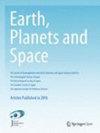Identification of active faults and tectonic features through heat flow distribution in the Nankai Trough, Japan, based on high-resolution velocity-estimated bottom-simulating reflector depths
IF 2.5
3区 地球科学
引用次数: 0
Abstract
Abstract Estimates of heat flow can contribute to our understanding of geological structures in plate convergent zones that produce great earthquakes. We applied automated velocity analysis to obtain the accurate seismic profiles needed for precise heat flow estimates using six new seismic profiles acquired during R/V Kaimei KM18-10 voyage in 2018. We calculated heat flow values in the accretionary wedge of the Nankai Trough off the Kii Peninsula, Japan, from the positions of widespread bottom-simulating reflectors (BSRs) in seismic reflection profiles. Calculated conductive heat flow values from the depth of the BSR agree with previous studies where a regional trend is observed from ~ 50 mW/m 2 to < 40 mW/m 2 60 km landward from the deformation front. This trend is caused by thickening of accretionary sediments and the subduction of the Philippines Sea plate. Segments of profiles are marked by anomalous high heat flow values. Such anomalies represent alterations of the shallow crustal thermal structure caused either by a combination of topographic affects, surface erosion of the seafloor, or by fluid flow that transports heat by advection. We interpret heat flow anomalies (~ 100 mW/m 2 ) as indicators of active faulting, which correspond to low seismic velocity zones along faults. Our results also showed relatively high heat flow at the landward end of several survey lines close to the Kii Peninsula, which we interpret to the possible presence of plutonic rocks that underlie the Kii Peninsula and extend offshore and may be the cause of geothermal springs, steep geothermal gradients, and high heat flow. Graphical abstract基于高分辨率测速模拟反射体深度的日本南开海槽热流分布识别活动断裂及构造特征
对热流的估计有助于我们理解产生大地震的板块会聚带的地质构造。我们利用2018年“开梅号”KM18-10航次获得的6条新地震剖面,应用自动速度分析获得精确热流估算所需的准确地震剖面。利用地震反射剖面中广泛分布的海底模拟反射体(BSRs)的位置,计算了日本Kii半岛南开海槽增生楔的热流值。从BSR深度计算的传导热流值与先前的研究一致,其中观察到从~ 50 mW/ m2到<的区域趋势;40兆瓦/米,从形变锋向陆地方向60公里处。这一趋势是由增生沉积物增厚和菲律宾海板块的俯冲作用引起的。剖面段的热流值异常高。这种异常表现了浅层地壳热结构的变化,这些变化可能是由地形影响、海底表面侵蚀或通过平流输送热量的流体流动共同引起的。我们将热流异常(~ 100 mW/ m2)解释为活动断层的指示,这对应于沿断层的低地震速度带。我们的研究结果还显示,在靠近Kii半岛的几条测量线的陆地端相对较高的热流,我们解释了Kii半岛下面可能存在深成岩并向外延伸,这可能是地热泉,陡峭的地热梯度和高热流的原因。图形抽象
本文章由计算机程序翻译,如有差异,请以英文原文为准。
求助全文
约1分钟内获得全文
求助全文
来源期刊

Earth, Planets and Space
地学天文-地球科学综合
CiteScore
5.80
自引率
16.70%
发文量
167
期刊介绍:
Earth, Planets and Space (EPS) covers scientific articles in Earth and Planetary Sciences, particularly geomagnetism, aeronomy, space science, seismology, volcanology, geodesy, and planetary science. EPS also welcomes articles in new and interdisciplinary subjects, including instrumentations. Only new and original contents will be accepted for publication.
 求助内容:
求助内容: 应助结果提醒方式:
应助结果提醒方式:


